Announcing: Visual Basic Windows Phone 7 Support RTW
I’ve personally been enjoying using my Windows Phone 7 device, and it’s been a lot of fun seeing the phones come to market across the world. As a developer, it’s an intriguing opportunity to see so many people buying Windows Phone 7 devices and starting to purchase applications on the Marketplace. With all this excitement around Windows Phone 7, I’m often asked by Visual Basic developers when they’ll be able to submit their applications to the Marketplace. I’m excited to announce that day is here!
Today we’re releasing “Visual Basic for Windows Phone Developer Tools – RTW”. This release is available in the same five languages as the Windows Phone Developer Tools:
- English: https://go.microsoft.com/fwlink/?LinkId=206790&clcid=0x409
- French: https://go.microsoft.com/fwlink/?LinkID=206790&clcid=0x40c
- German: https://go.microsoft.com/fwlink/?LinkID=206790&clcid=0x407
- Italian: https://go.microsoft.com/fwlink/?LinkID=206790&clcid=0x410
- Spanish: https://go.microsoft.com/fwlink/?LinkID=206790&clcid=0x40a
Please refer to the download pages for a list of System Requirements and Support Statements associated with the release.
To get started with the release, be sure to check out the Visual Basic Code Samples for Windows Phone: https://msdn.microsoft.com/en-us/library/ff431744(VS.92).aspx.
There are also forums available where you can post your questions:
- Silverlight for Windows Phone Forum: https://forums.silverlight.net/forums/63.aspx
- Windows Phone 7 Development Forum on App Hub: https://forums.create.msdn.com/forums/98.aspx
Walkthrough
To show the experience of building a Silverlight application with Visual Basic for Windows Phone Developer Tools - RTW, lets review a walkthrough highlighting the steps to build my Tip Calculator application in VB. (You can find the complete VB solution posted here.)
First start by installing the System Requirements:
- Windows 7 or Windows Vista
- Visual Studio 2010 Professional, Premium or Ultimate. If you don’t have one of these releases, you can also install a trial version: Ultimate | Premium | Professional
- Windows Phone Developer Tools RTW
- Visual Basic for Windows Phone Developer Tools - RTW
When you go to create a New Project, you will see a new Visual Basic project template node under Visual Basic -> Silverlight for Windows Phone. There are 5 Visual Basic Windows Phone project types available, in addition to 16 item templates.
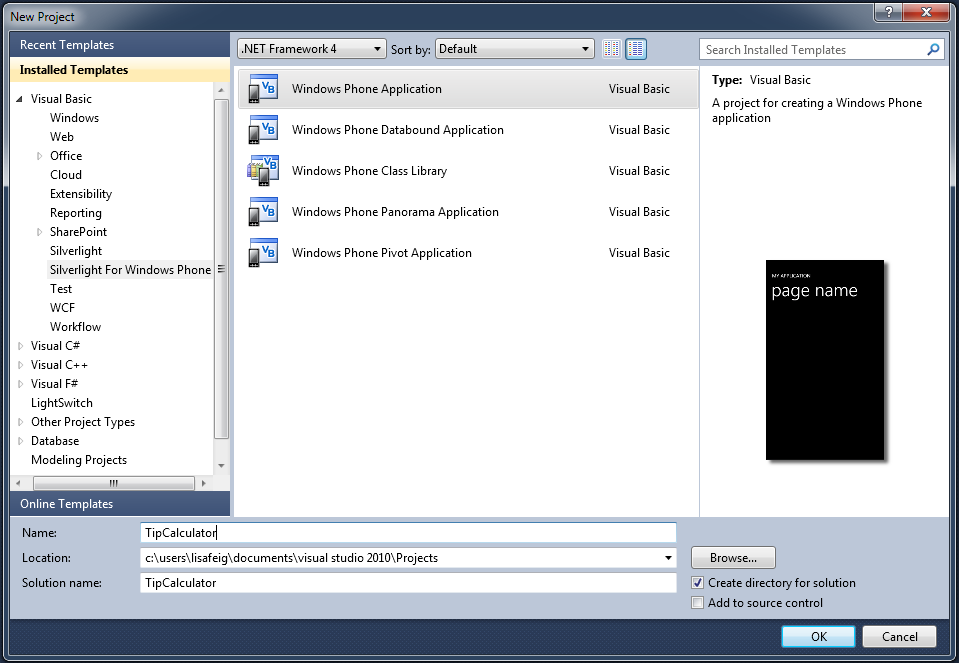
In this case, we select the ‘Windows Phone Application’ template.
(Please note that there are no Visual Basic XNA templates available at this time, since XNA is not currently supported in Visual Basic. This is consistent with the experience in the Visual Basic CTP for Windows Phone Developer Tools.)
Layout
My earlier Tip Calculator post described the process for laying out the application shown below. Please refer to that post for details. The same designer experience is now available for Visual Basic Windows Phone applications.
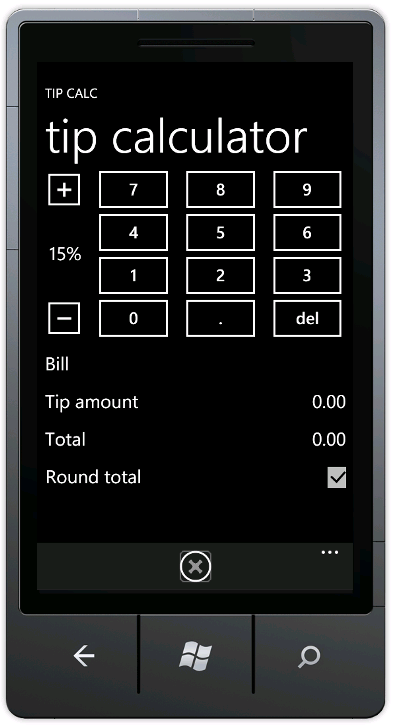
The application has a built-in numeric key pad for entering the bill amount and controls which allow for adjustment of both the tip percentage, as well as, rounding the total bill to an even number.
In this post, I’ve included Visual Basic versions of the code snippets from my previous post. These code snippets describe how to implement different aspects of the application. For example, below is the code to implement Landscape and Portrait Mode, so that the application layout changes when the user rotates the phone. In order to do this, the application must indicate that it supports the setting and it must handle the change in orientation event as follows:
In MainPage.xaml.vb, add the following line in Sub New():
1: SupportedOrientations = SupportedPageOrientation.Portrait Or SupportedPageOrientation.Landscape
In MainPage.xaml.vb, update the MainPage_OrientationChanged method to handle the Me.OrientationChanged event:
1: Private Sub MainPage_OrientationChanged(ByVal sender As Object, ByVal e As OrientationChangedEventArgs) Handles Me.OrientationChanged
2: ...
3:
4: End Sub
When the orientation changes we’ll first move the TotalsGrid into the second column adjacent to the NumbersGrid, then change the column width attributes accordingly:
1: Private Sub MainPage_OrientationChanged(ByVal sender As Object, ByVal e As OrientationChangedEventArgs)
2: ' In landscape mode, the totals grid is moved to the right on the screen
3: ' which puts it in row 1, column 1.
4: If (e.Orientation And PageOrientation.Landscape) <> 0 Then
5: LandscapeColumn.Width = GridLength.Auto
6: Grid.SetRow(TotalsGrid, 1)
7: Grid.SetColumn(TotalsGrid, 1)
8:
9: LayoutRoot.ColumnDefinitions(1).Width = GridLength.Auto
10: ' In portrait mode, the totals grid goes below the number pad at the
11: ' bottom of the screen which is row 0, column 2.
12: Else
13: LandscapeColumn.Width = New GridLength(0)
14: Grid.SetRow(TotalsGrid, 2)
15: Grid.SetColumn(TotalsGrid, 0)
16:
17: LayoutRoot.ColumnDefinitions(1).Width = New GridLength(0)
18: End If
19: End Sub
The resulting display then looks like the following:
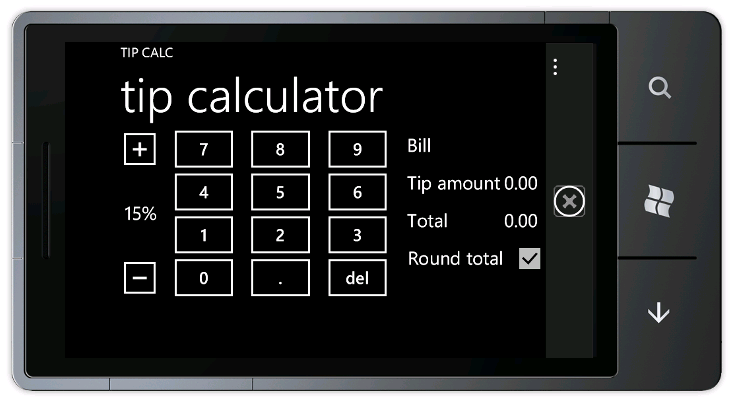
Button Handlers
The numeric button grid is implemented in xaml as a 3 x 4 grid. Each numeric button is given a name “button[x]”, corresponding to its value. When a button is pressed, we want to add that new digit to the bill amount. This is perfect place to take advantage of Visual Basic Statement Lambdas feature, introduced in Visual Studio 2010:
1: Private Sub InitButtonHandlers()
2: For i = 0 To 9
3: Dim btnName = "button" & i.ToString()
4: Dim btn = CType(Me.LayoutRoot.FindName(btnName), System.Windows.Controls.Button)
5:
6: Dim j = i ' avoid local variable capture
7: AddHandler btn.Click, Sub(sender As Object, e As RoutedEventArgs) TryUpdateBillAmount(textBlockBill.Text + j.ToString())
8: Next i
9: Sub
Debugging With the Emulator
Like the C# debugging experience, VB debugging is also very simple - just press F5! By default the emulator is your target:

You can now test the application easily using the normal Visual Studio debugger and emulator controls. For example, to test landscape mode, simply select the direction you want to rotate the device:
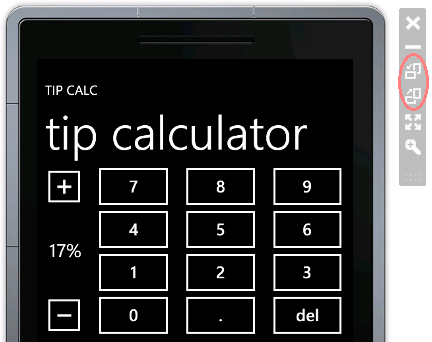
Building to Release
Assuming we’re all done developing the application and are ready to submit it to the marketplace, we’ll now change the configuration to Release and Rebuild:

In the Bin\Release folder, you will now find a XAP file, which is the package you will submit to the marketplace.
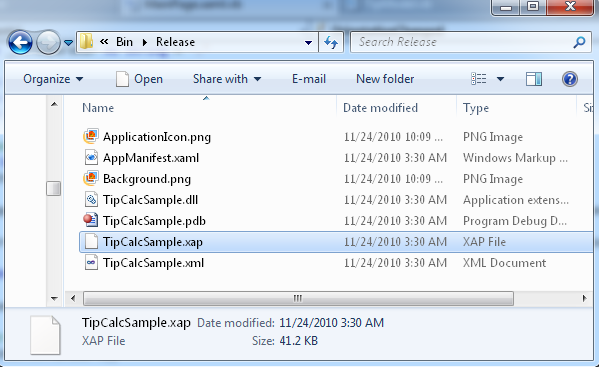
Publishing the Application
Your best one-stop shop for resources about publishing your application is https://create.msdn.com.
To submit an application to the Windows Phone Marketplace, you’ll first need to register and become a member here: https://create.msdn.com/en-us/home/membership
Here are a few additional resources to review before submitting:
- Windows Phone 7 certification requirements
- How To: Use the Windows Phone Capability Detection Tool
- UI Design and Interaction Guide for Windows Phone 7
- Best Practices for Application Marketing
- FAQ (including pricing considerations)
Finally you can use the application submission walkthrough, to guide you through the submission process.
Summary
You can find the full source code for the Visual Basic Tip Calculator application here. The application uses general Silverlight and Visual Basic features, which are available in other application types, and now also apply to the phone. As a VB developer, you’re well-positioned for success creating Windows Phone 7 applications.
Enjoy!
Comments
Anonymous
November 29, 2010
When can we get back Visual C++ for Windows Phone?Anonymous
November 29, 2010
@native dev - unfortunately we do not have C++ for Windows Phone at this time, sorryAnonymous
November 30, 2010
Why not concentrate on 1 language, instead of now causing this fragmentation. So now example code/open source projects are going to be either c# or vb, hardly anyone maintained code in both languages, so it's gonna be a big pain point for C# programmers looking at VB examples/projects, and vice versa.Anonymous
November 30, 2010
Not to sound ungrateful, but when will the templates for Expression Blend using VB.Net for Windows Phone work?Anonymous
November 30, 2010
@james - We have a firm commitment to Visual Basic and C# parity and have developers skilled in both languages. We had actually tried to get the VB support into the final build of WP7 but due to schedule risk kinds of issues we had to defer a bit until this release. @Matt - Nothing to announce yet in this release, sorry, we have been concentrating on getting the core work going. I'm checking on the ETA from the Expression team on thier support, stay tuned...Anonymous
December 03, 2010
This is great news! I was waiting for VB.NET!! Now I can start developing..Anonymous
December 15, 2010
Any news about the release date for the WP7 VB templates for Expression Blend? Like many others I have a powerful product which I still cannot use to get productive with WP7 development.Anonymous
December 20, 2010
Still no blend support. Amazing that MS wonders why it is behind in the mobile space, and they don't even take the time to release fully baked tools. How do you expect to do development making plain vanilla interfaces?